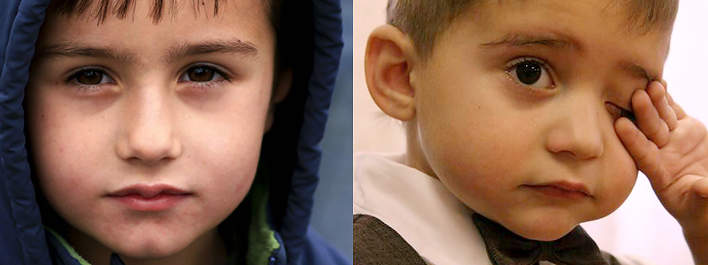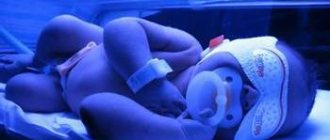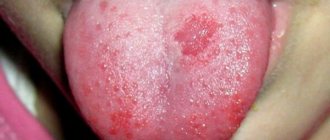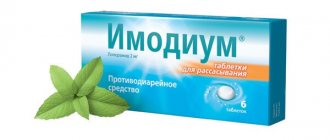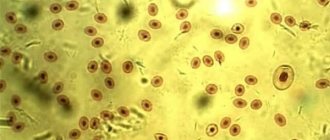Causes of dark circles under the eyes of a child
What could cause such an incomprehensible sign to appear? There are several main reasons:
- Chronic lack of sleep or overwork.
- Hereditary factor.
- Vegetovascular dystonia.
- Iron deficiency anemia.
- Avitaminosis.
- Helminthiasis.
- Periorbital idiopathic hyperchromia.
- Lack of water in the child's body. Fluid deficiency lowers blood pressure. This especially affects blood circulation in the periocular area - dark venous blood begins to accumulate, which becomes the cause of circles under the eyes in children.
- On the contrary, drink plenty of fluids. In this case, swelling is added to the circles.
Note that the skin under the eyes is one of the thinnest. Its thickness is 0.5 mm, so blood and lymphatic vessels are sometimes visible through it. If venous blood begins to accumulate in the capillaries of this zone, known, as we noted earlier, to be dark in color, then the area under the eyes changes its light shade to brownish, bluish, grayish or even blackish.
Let's look at some of the reasons in more detail below.
Why do my child have red circles under his eyes?
Many factors can cause redness under the eyes in children - from ordinary overwork and lack of sleep to pathological changes in the body of an infectious and non-infectious nature.
Red-blue spots under the eyes, as a consequence of a physiological feature, do not cause discomfort and are not a pathological phenomenon. The child feels well, there are no complaints or accompanying symptoms.
In this photo there is most likely a heart problem
If a symptom is detected, you should immediately contact your pediatrician
Fatigue and VSD
What causes circles under the eyes in children in this case? It's all about cortisol, which is of great importance for preserving the energy resources of our system. Fighting fatigue, the body begins to produce it twice as much. This is necessary so that we simply do not fall asleep on the spot.
This adrenal hormone increases blood volume in the body. The vessels begin to overflow with it. Including those located in the periorbital region.
We also include vegetative-vascular dystonia (VSD) among this reason. The disease is characterized by a chronic feeling of fatigue, loss of strength, and general weakness of the body. Another characteristic sign of VSD is pale and dry skin.
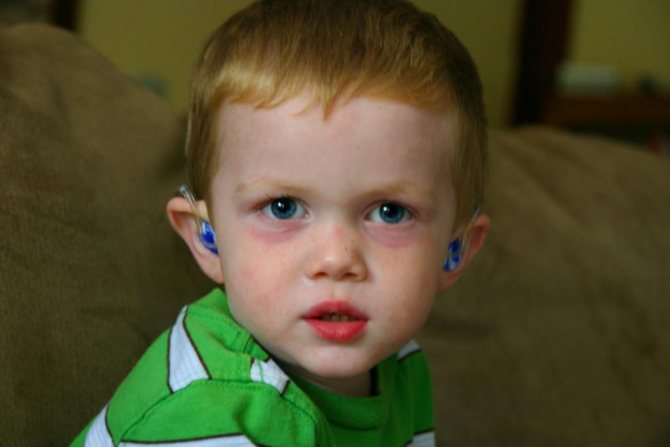
Iron-deficiency anemia
This disease can also be the cause of dark circles under the eyes of a child. In its manifestation it is quite similar to VSD. The pathology is associated with a significant decrease in hemoglobin levels. As a result, the partial pressure of oxygen in the venous blood increases, and hypoxia begins to manifest itself - an insufficient level of oxygen in the body.
In addition to dark circles, iron deficiency anemia is characterized by dizziness and chronic colds. If such alarming signs occur, you should consult a specialist as soon as possible.
Alarming symptom
Blue circles under the eyes appear immediately after a head injury, in particular a concussion. If a child hits his head or falls from a height, parents carefully monitor the condition of the baby. If the baby becomes restless or, conversely, lethargic, this may indicate a concussion. Signs of serious injury include vomiting, pale skin, incoordination, and loss of consciousness. If a child exhibits at least some of the symptoms mentioned, it is necessary to call an ambulance.
Undoubtedly, parents always notice the appearance of various defects in their baby in the form of bruises and scratches. However, sometimes symptoms arise that are difficult to immediately explain. One of these manifestations is dark circles under the eyes of a child, the causes of which require consultation with a doctor, and in some cases, a series of tests.
Avitaminosis
Vitamin deficiency can also cause circles under the eyes of a child:
- Lack of vitamins B9, B12, C leads to incomplete absorption of iron by the body.
- Lack of vitamin D. Chronic feeling of fatigue, which provokes the appearance of dark circles under the eyes. In addition, bone tissue becomes fragile, chronic pain and depression appear.
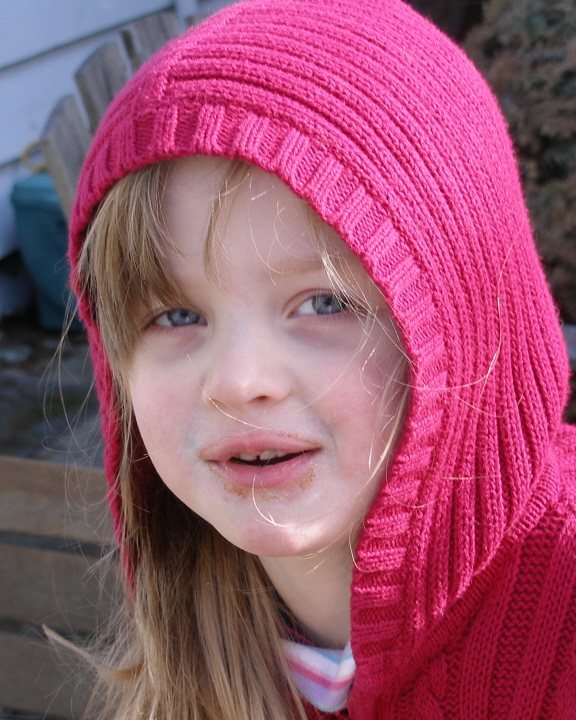
What examinations are needed
Mostly, just a visual assessment of the child’s condition is not enough to make a diagnosis. The specialist conducts a thorough examination of the patient’s medical history, clarifying the diseases he suffered in childhood. In addition, attention is paid to the diseases of the parents, the characteristics of the child’s behavior, adherence to the regime and proper nutrition.
Diagnosis of the causes that caused the appearance of circles under the eyes includes the following procedures:
- analysis of urine, blood and feces;
- X-ray of the chest area;
- Ultrasound of the peritoneal organs.
Based on the results obtained, the cause of the circles under the eyes is determined, and, if necessary, the necessary treatment is selected.
Helminthiasis
Why does my child have circles under his eyes? The cause may be the following type of helminthiasis:
- Giardiasis.
- Trichinosis.
- Opisthorchiasis.
Enzymes and substances generated by the vital activity of parasites begin to accumulate in the child’s body. In parallel with dark circles, the following symptoms also make themselves felt:
- Decreased appetite.
- Allergy.
- Impaired absorption of nutrients by the body.
- Delays in the growth and development of the child.
Bruises under the eyes of a child: causes, treatment: Healthy eye
In the fight for the health and well-being of their baby, parents have only one weapon - attention. What to do if your child has bruises under his eyes? Should I run to the doctor or will the problem go away on its own? Let's consider the possible options
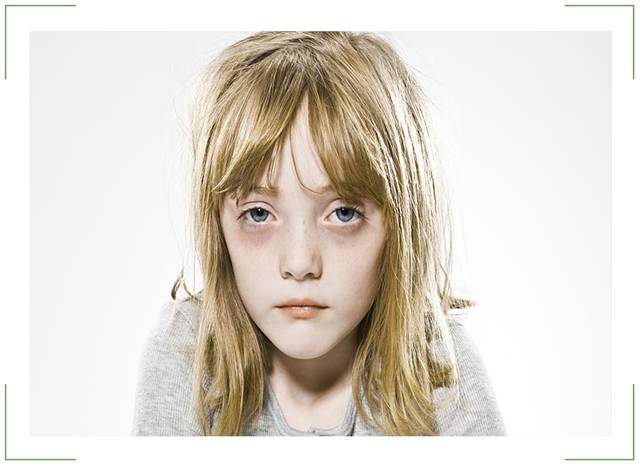
About harmless and easily removable reasons
No matter what alarmed grandmothers say, without cross-symptoms, the appearance of bruises or bags under the eyes in 70% turns out to be a natural reaction of the body to minor changes in the regime that are easy to adjust.
“I was born this way”
Children with blond hair and blue eyes are also characterized by thin, “translucent skin” - due to the proximity of the finest capillaries to the surface, the area under the eyes takes on a blue-violet color. This phenomenon is absolutely harmless and often remains with the child for life. With age, facial features change, and bruises go away with them.
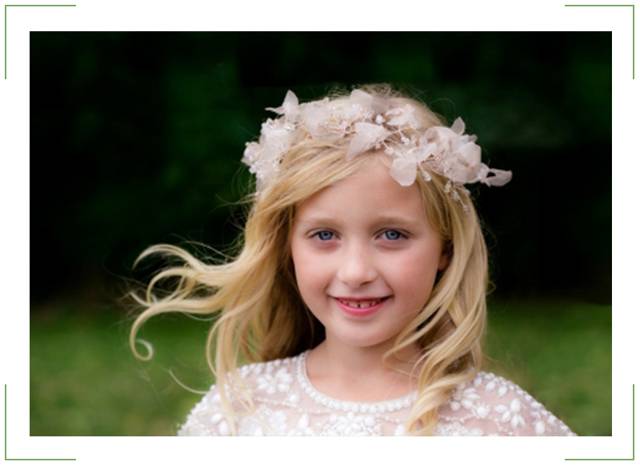
Overwork and exhaustion
It happens that an excellent student who is actively involved in sports wakes up one day with circles around his eyes. They can be caused by banal overwork during preparation for tests or competitive competitions. Make sure that your future medalist has enough time for restful sleep, outdoor play and healthy food.
Poor nutrition and vitamin deficiency
With food, the child’s body receives the necessary minerals and trace elements, which not only give him strength, but also help remove toxins that daily attack all human functional systems. A healthy diet with minimal control of the diet (three times a day, as well as snacks) will save your baby’s face from bruises under the eyes.

Genetic factor
In many families, deep-set eyes are inherited. If mom or dad has noticeable circles under the eyes, there is no need to complain about the disease - most likely the time has come for the manifestation of a congenital facial feature. In this case, there is no point in trying to fix the problem.
Stress, overwork
Spots in the eye area are caused by illness, flights, and psychological abuse.
The sensitive body of a child has difficulty coping with this lifestyle, which even adults can only calmly tolerate by taking valerian.
If the child has not been sick and has not been on a long trip, make sure that no one around him is putting pressure on him, or that there are no conflicts at school or company.
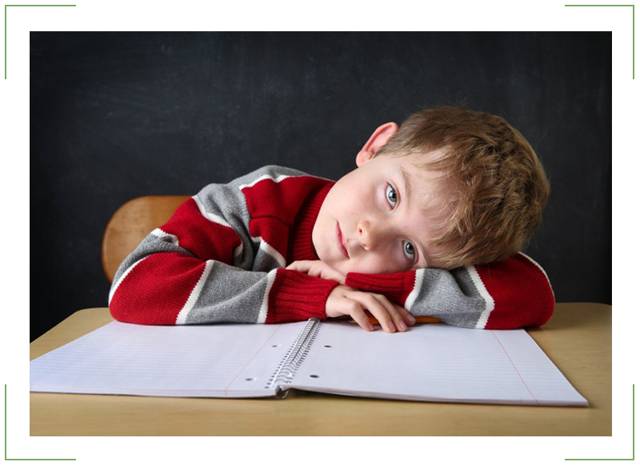
Violation of the daily routine
For some parents, feeding or sleeping on demand is not a problem. There really is no danger in this mode, only if you still manage to monitor the number of hours the child sleeps and the quality of the food he eats.
Sleepless nights, snacking on fast food or sweets negatively affect the functioning of the body. Infants sleep 19-20 hours a day, and preschoolers need a “quiet hour” in the afternoon. Without rest, children may feel normal and be active, but negative changes start from within.
The first signal will be irritability of your son or daughter and the notorious dark circles.
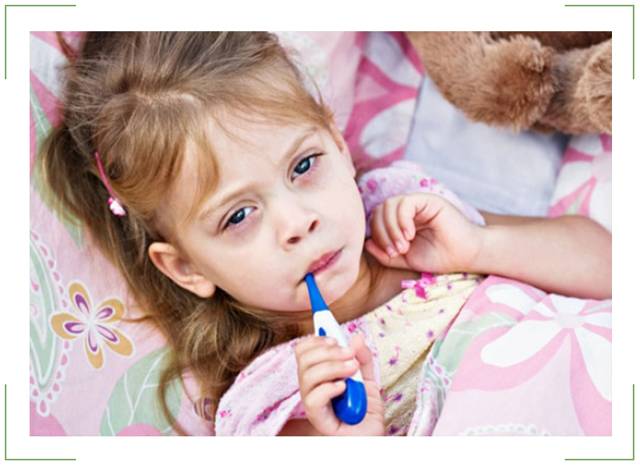
About “painful” reasons
Sometimes only medical examinations will help to understand why a child has bruises under his eyes. Blueness on the face occurs as a symptom of serious internal damage and dysfunction of organs.
Soft tissue injuries
While running around on the street, arguing with friends, or through carelessness, guys often get black eyes. Capillaries located near the skin wall are damaged and local hemorrhage occurs. But don’t think that your baby can’t get injured at home.
Inquisitive craftsmen climb on furniture, open cabinets, take toys from the bottom of the basket and in the process receive direct injuries to the face, often in the eye area
But don’t think that your baby can’t get injured at home. Inquisitive craftsmen climb on furniture, open cabinets, take toys from the bottom of the basket and in the process receive direct injuries to the face, often in the eye area.
These injuries are characterized by concomitant swelling, sometimes excessive lacrimation.
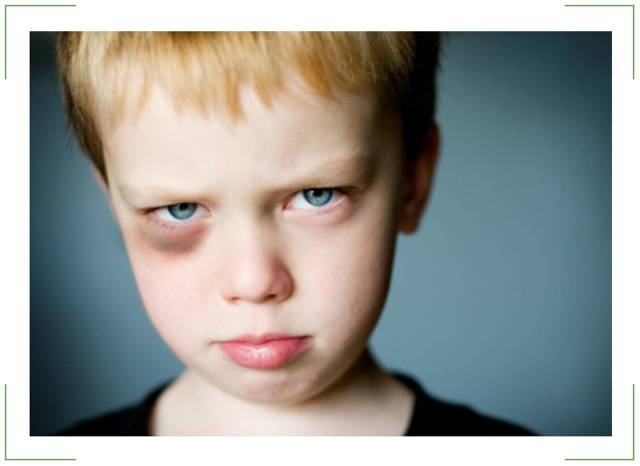
In case of a fracture or severe bruise of the nose, distinct blue marks also appear under the eyes. Even if the boy got into a fight and didn’t confess, the bruises would give him away. Lightly touch the baby’s nose; if this is the problem, immediately take him to a traumatologist.
If there is a fall or a strong blow to the abdomen, there is a risk of internal bleeding. Paleness of the face and blueness around the eyes are not key, but rather complementary symptoms. Examine the child, have you noticed a hematoma? Perhaps the incident occurred last evening, and the baby was afraid to talk about what happened.
Idiopathic hyperchromia
This phenomenon is characterized by hyperpigmentation of the skin not only under the eyes, but also in the eyelid area. The reason is the excessive production of melanin pigment.
Hyperchromia is more common in people with dark hair and dark skin. But it is still a mystery to specialists why melanin in the periorbital area begins to be produced excessively. The phenomenon practically does not occur in infants, but can manifest itself as they grow older.
This is the reason for blue circles under the eyes of a child. When the baby is exposed to light, with idiopathic hyperchromia, the periorbital areas of the eyelids also acquire a bluish tint.
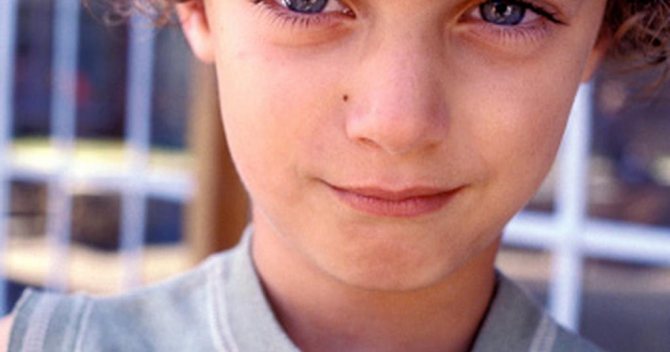
Preventing redness under the eyes of a baby
In order not to wait for redness under your baby’s eyes, it is better to adhere to a number of rules:
- A child needs healthy sleep.
- The baby must have proper nutrition.
- The baby needs to drink enough water.
- The baby needs to spend as much time outdoors as possible.
- Make sure that the child does not rub his eyes.
- Watch your baby; perhaps some foods or things cause him allergies.
- It is necessary that the baby goes to bed with a clean face, since fat remaining on the face can become a source of bacterial growth and, as a result, inflammation of various kinds.
We follow these rules, thus protecting the baby not only from the occurrence of redness under the eyes, but also from diseases that cause this symptom.
A healthy baby means happy parents. Unfortunately, young children are still very vulnerable due to insufficiently developed immunity. Therefore, parents should be sufficiently observant and in case of any deviations, contact a specialist in a timely manner.
Swelling of the eyelids, red circles under the eyes of a child against a background of general weakness and malaise are the result of overwork, infectious eye diseases, inflammation of internal organs, and injuries. Determining the cause of unpleasant symptoms helps to quickly eliminate the problem and prevent the development of complications.
Red circles can be either a simple allergy or a serious illness
Kidney diseases
If a child suffers from kidney disease associated with inflammatory processes in the glomeruli, then he may develop dark circles under the eyes, as well as swelling of the eyelids and soft tissues after sleep in this area. Such symptoms indicate post-infectious glomerulonephritis, which may be a consequence of pharyngitis or tonsillitis caused by beta-hemolytic streptococci.
The following warning signs also manifest themselves:
- Increased body temperature.
- General weakness.
- Headache.
- Dyspnea.
- Painful sensation in the lower back, abdomen.
- Problems with the urination process.
Color and reason
The color of circles under the eyes may indicate the specific cause of their appearance.
| Bluish | Most likely, this is an individual characteristic of the child - the capillaries in the periorbital region lie close to the skin. |
| Bluish, purple | The color indicates fatigue or overwork. In addition, it may indicate heart problems or hypoxia. If a child is diagnosed with a heart defect, then such a symptom indicates the development of periorbital cyanosis - a local version of this disease. Its cause is circulatory disorders, an increase in the proportion of reduced (in other words, not combined with oxygen) hemoglobin. |
| Black | A sign of dehydration or iron deficiency. |
| Yellowish gray | The level of the bile pigment bilirubin in the plasma increased greatly. |
| Brownish | Indicates diseases of the gallbladder or liver. |
| Reddish | Red circles under a child's eyes are a sign of developing allergic reactions. |
Let's move on to the next section.
Factor five – development of anemia
One of the problems with the formation of circles under the eyes is iron deficiency anemia. Lack of iron first of all. It affects the condition of the skin, bruises under the eyes may occur due to thinning and dry skin, and they can appear long before changes in the blood test and are a sign of hidden iron deficiency.
If bruises appear and become pronounced, all examination activities begin with a blood test and exclusion of anemia. Anemia is especially dangerous for infants; in them it can lead to eating and growth disorders.
Even if the analysis shows no anemia, and the circles under the child’s eyes are quite stable, it is necessary to carefully monitor the baby and monitor hemoglobin, since anemia can exist for quite a long time as a latent iron deficiency. Then the body tries to compensate for the shortage from reserves, but gradually the reserves are depleted.
In this case, you need to adjust the child’s menu to include meat and meat products. Rich in iron, as well as vitamins and minerals that help the absorption of this mineral are buckwheat, liver, apples and juices. If iron deficiency is detected, drug treatment with iron supplements is necessary.
Other diseases
Circles under the eyes of a child (photo examples are presented throughout the article) may indicate the development of a number of other diseases. Here is their list:
- Atopic dermatitis.
- Congenital liver cyst.
- Frontit.
- Viral hepatitis.
- Hepatolenticular degeneration.
- Adenoiditis.
- Hay fever (allergic reaction to pollen).
- Bronchial asthma.
- Acute sinusitis.
- Tonsillitis.
- Sinusitis.
- Thyroid diseases.
- Caries.
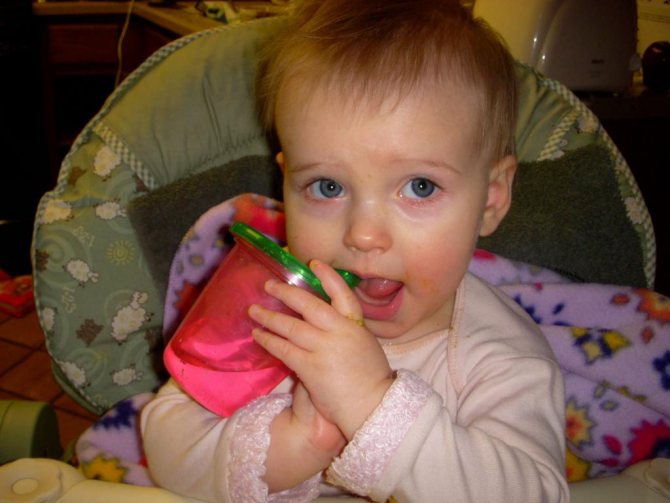
Yellow or brown
What do yellow circles under a child’s eyes mean? A yellow tint always indicates a problem with the liver or gallbladder. This is explained by an increase in the concentration of bilirubin in the blood plasma. Bilirubin is one of the components of bile, a bile pigment. An increased content of pigment in the blood is observed in the presence of the following pathologies:
- destruction of red blood cells (for example, hemolytic jaundice);
- problems with removing bilirubin from the body (obstruction of the bile ducts).
Yellow and brown color of the periorbital area indicates liver problems. The severity of the condition will be determined by the doctor. Perhaps the problem will be solved by a strict diet. Circles can be a symptom of viral hepatitis, liver cysts.
Diagnosis of the problem
From all of the above, it is clear that it is difficult to determine the only true cause of their appearance based on circles under the eyes alone. It is worth contacting a pediatrician who will collect a complete history, including all the diseases from which the child has suffered during his life. It is important for the doctor to be aware of the pathologies, illnesses of the parents, close relatives, daily routine, behavior, and diet of the little patient.
In particular, the following examination is prescribed:
- Blood, urine and stool tests.
- Ultrasound of abdominal systems.
- Chest X-ray.
- Consultation with specialists - nephrologist, otolaryngologist, cardiologist, gastroenterologist.
How is the disease diagnosed if there are circles under the eyes?
It is impossible to begin treatment for circles under the eyes without an accurate diagnosis. Visually it is impossible to determine the exact cause of the disease. Therefore, the doctor prescribes a number of necessary tests, ultrasound and chest x-ray. Also, the pediatrician studies the medical history of the child and his parents.
Some diseases can be hereditary. Often, consultation with highly specialized doctors is required: cardiologists, neurologists or nephrologists. Only after a thorough examination and diagnosis is established, treatment is prescribed.
It is not permissible to independently find out the reasons for the appearance of circles under the eyes. This can be dangerous both for the health and life of the child.
Treatment
A child has circles under his eyes - what to do? This phenomenon is a symptom, so it is impossible to specifically cure it. The cause that caused this symptom should be eradicated.
Therefore, independent treatment is not allowed here. The disease that causes circles under the eyes can be very serious and can only be diagnosed using special equipment. A comprehensive treatment regimen developed by a doctor is required.
For example, if there is a lack of vitamins, multivitamin preparations or medications with specific properties are prescribed. If the cause of dark circles is helminthiasis, then the child is prescribed antihistamines in parallel with compliance with the rules of sanitary and hygienic behavior.
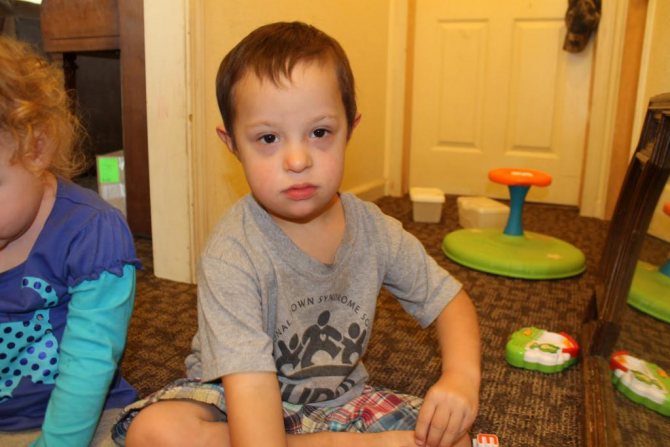
Prevention of the problem
The main direction of prevention is to prevent the manifestation of the cause that causes such a symptom. In addition, there are a number of general recommendations:
- Maintaining an age-appropriate sleep/wake schedule.
- Varied recreation - active, home.
- Minimizing time spent on a computer, smartphone, TV.
- Sleep at least 8 hours a day.
- Balanced, varied meals at least 4 times a day.
- Normal physical activity for age.
- Daily long walks in the fresh air.
- Minimizing stress, nervous tension, obtaining bright positive emotions.
Eliminate circles under the eyes
If circles under the eyes are caused by hereditary factors, then it is, of course, useless to fight them. You can use a harmless product, which, according to some experts, helps reduce the level of skin pigmentation in the periorbital area. These are cold milk compresses that are applied under the eyes twice a day.
Chilled chamomile decoction in filter bags also helps to get rid of the phenomenon itself. They need to be applied under the eyes for 15-20 minutes. Children's vitamins and facial massage help. However, they should only be prescribed by a doctor.

Often it is enough to even out your diet - add more fruits, fish, vegetables, soups, meat, cereals, dried fruits and nuts. Avoid fast food, snacks, and sweet carbonated water.
Walking in the fresh air also helps improve your complexion. However, their duration each day should not be less than two hours. It is necessary to combine this with high-quality healthy sleep - as we have already noted, at least 8 hours a day. Perhaps the child is chronically tired. Maybe you should give up some section or extra classes?
Circles and puffiness under the eyes also appear because the child drinks a lot. During the day, it can replenish the water balance in unlimited quantities, but after six o’clock in the evening - no more than 1-2 glasses. This prevents the appearance of dark circles under the eyes in the morning.
So we figured out the reasons and their elimination. In any case, if you notice circles under your child’s eyes, you need to play it safe and consult a specialist.
Types of bruises under the eyes in children
According to statistics, 30% of children develop bruises in the eye area at one age or another. The prevalence of the pathology is facilitated by a large number of provoking factors. They are not always dangerous to health, but require urgent measures.

For example, red bruises under the eyes of a child occur as a result of allergies. This can also affect the reaction to viral lesions or complex infections.
- A yellowish tint of cyanosis in the eye area indicates problems with the liver or kidneys.
- When purple bruises develop, you need to urgently take a blood test to determine your hemoglobin level. It is possible that anemia may develop.
- Dark, almost black, circles under the eyes develop when overworked. It is necessary to adjust the mode of activity and rest.
- If a child has suffered an injury to the bridge of the nose, the dark bruises will become lighter as they recover.
